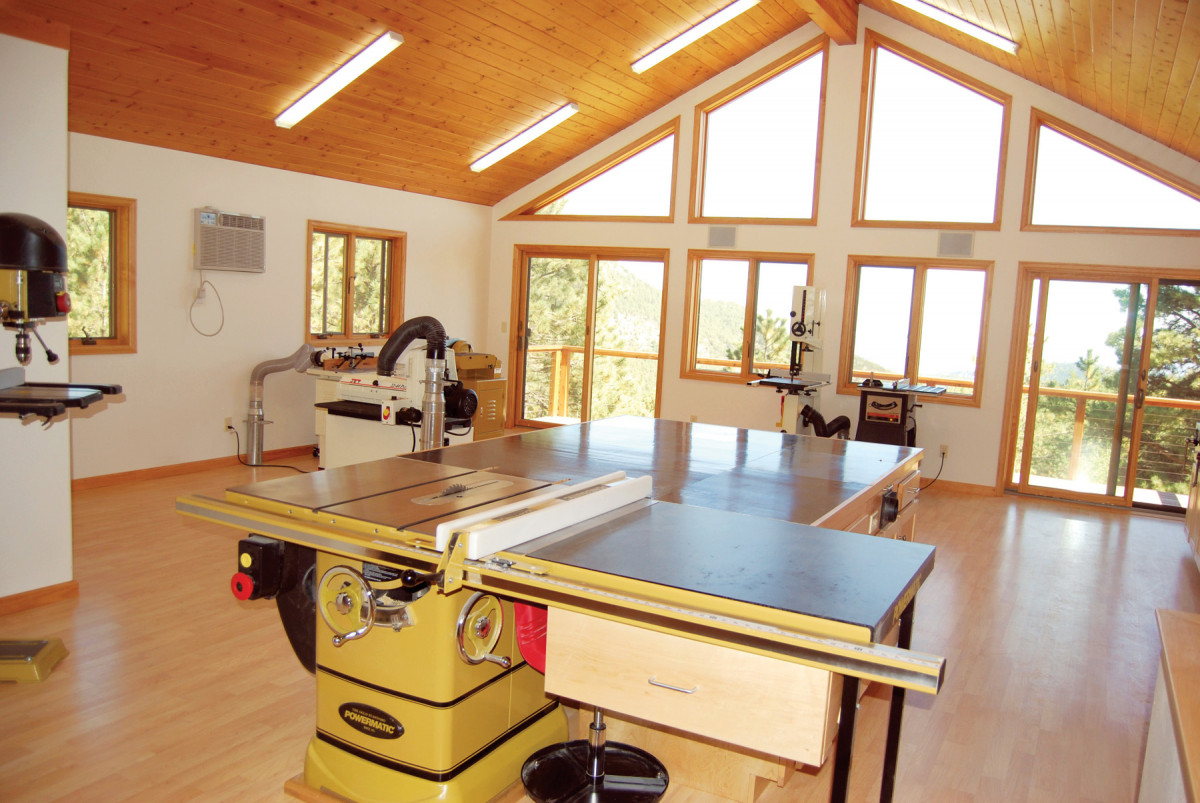We may receive a commission when you use our affiliate links. However, this does not impact our recommendations.

A Shop with a View
A few years ago, I moved to a Colorado mountain area on five acres, which gave me plenty of room to build my dream shop, a two-story design with 850 sq. ft. on each level. The upper floor houses my woodworking equipment in a spectacular room with a vaulted tongue-and-groove ceiling that’s supported by a large laminated central beam. This construction eliminates support columns, thereby preserving valuable floor space. An air filter mounted below the ceiling beam provides ambient dust control. The floor is wood, which, as every woodworker knows, is much more comfortable than concrete. Double entry doors make it easy to move lumber in and completed projects out. This level also has a separate finishing room outfitted with an HVLP sprayer.
 The basement level houses an Oneida dust collection system ducted to all the machines above and a 60-gallon air compressor with runs to three locations upstairs. There’s plenty of room for wood storage as well. This layout works great, because all the noisy mechanical equipment is downstairs and all of the ducts and piping are out of the way. Large doors make loading and unloading a breeze.
The basement level houses an Oneida dust collection system ducted to all the machines above and a 60-gallon air compressor with runs to three locations upstairs. There’s plenty of room for wood storage as well. This layout works great, because all the noisy mechanical equipment is downstairs and all of the ducts and piping are out of the way. Large doors make loading and unloading a breeze.
 My shop is efficient to heat, because all the exterior walls have sprayed-in foam insulation. Air conditioning is rarely necessary in this mountain climate, so most of the time, the ceiling fan provides adequate cooling. A wall-mounted air conditioner stands ready, just in case.
My shop is efficient to heat, because all the exterior walls have sprayed-in foam insulation. Air conditioning is rarely necessary in this mountain climate, so most of the time, the ceiling fan provides adequate cooling. A wall-mounted air conditioner stands ready, just in case.
 When I built the shop cabinets, I used some tricks to save space and make it easier to handle lumber and plywood. For example, all of the tool and work surfaces are the same height (and even the stairwell wall cap), so no matter what tool I’m using, I won’t bump into an obstacle at a different height.
When I built the shop cabinets, I used some tricks to save space and make it easier to handle lumber and plywood. For example, all of the tool and work surfaces are the same height (and even the stairwell wall cap), so no matter what tool I’m using, I won’t bump into an obstacle at a different height.
 The tablesaw’s large outfeed cabinet is the heart of my shop. The top is made from phenolic plywood for a smooth, low-resistance surface. It has a removable section that reveals a recess for my planer, so I can use the cabinet’s long, flat surface for support when I’m planing. Similarly, a drop-leaf table at the end of the cabinet is designed to position my router table flush with the surface. Dust collection is built in. And as the cabinet is completely outfitted with doors and drawers, both the planer and the router table can store inside.
The tablesaw’s large outfeed cabinet is the heart of my shop. The top is made from phenolic plywood for a smooth, low-resistance surface. It has a removable section that reveals a recess for my planer, so I can use the cabinet’s long, flat surface for support when I’m planing. Similarly, a drop-leaf table at the end of the cabinet is designed to position my router table flush with the surface. Dust collection is built in. And as the cabinet is completely outfitted with doors and drawers, both the planer and the router table can store inside.
 I’ve been building toys for my grandchildren and projects for family members lately, but woodworking has been a lifelong passion. –Gene Fischer
I’ve been building toys for my grandchildren and projects for family members lately, but woodworking has been a lifelong passion. –Gene Fischer
Editor’s note: This article originally appeared in American Woodworker #148.
Here are some supplies and tools we find essential in our everyday work around the shop. We may receive a commission from sales referred by our links; however, we have carefully selected these products for their usefulness and quality.








